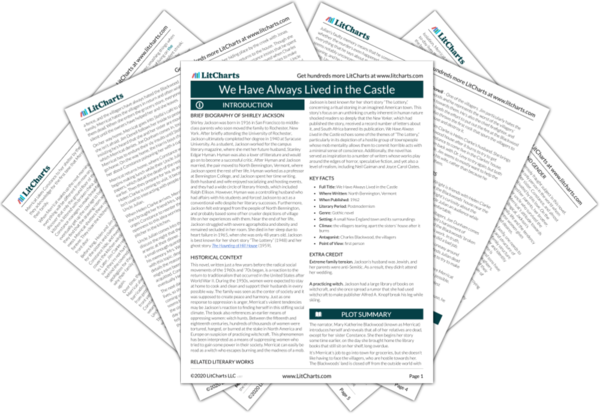Female Power
Throughout the novel, the actions of the female characters reveal a desire for revolt against the patriarchy. Due to family tragedy and social isolation, Merricat and Constance have power over their day-to-day lives that is unusual for young women in the 1960s, and the book is concerned with the sisters’ struggle to defend that power from men who would usurp it. The sisters’ ultimate triumph is that they succeed in banishing these men from their…
read analysis of Female PowerFamily and Gender
Family is an intensely fraught subject in this novel. On one hand, the only person in the world whom Merricat loves is her sister, Constance, and almost everything Merricat does is motivated by this love. On the other hand, Merricat has murdered her parents, her brother, and her aunt, and she lives with her uncle who survived the murders simply due to luck. While Merricat’s attitude towards family might seem to be chaotic and…
read analysis of Family and GenderGuilt and Punishment
This novel revolves around an unsolved crime: the murder of Merricat and Constance’s family six years earlier. While Constance was initially blamed for the poisoning, she was acquitted at her trial, which left the public with no clear answer about who was actually to blame. Meanwhile, Merricat—the real murderer—is never publically suspected, though, privately, Constance knows Merricat was responsible. The extent to which Constance was complicit in the murder is never fully clear, and…
read analysis of Guilt and Punishment
Isolation
Constance and Merricat have cut themselves off from the world almost entirely since the deaths of their family. Although Constance fears the outside world, the story takes place at a time of change, when she’s beginning to wonder whether it’s time to face society again. She is partially receptive to Helen Clarke’s urging her to return to the world, though she’s also frightened at the prospect. Merricat also fears the outside world, but she…
read analysis of IsolationThe Relativity of Truth
Because the story revolves around a mysterious past event, much of the narrative prompts the reader to try to figure out exactly what happened on the fatal night of the poisoning. Throughout the novel, there is a sense that this truth lies just out of sight. For some characters (like the villagers and Uncle Julian), truth is the same as conjecture, and for the two characters that do know the truth (Merricat and…
read analysis of The Relativity of Truth






